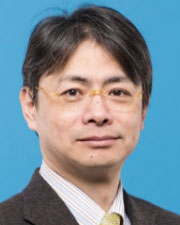B02 Modeling of ultra-adaptive to body change
Research Outline

Yasuharu KOIKE
Our group aims at the modeling of the mechanism underlying the recovery of the motor function after the alteration of the body, especially from the viewpoint of the reconstruction of a neural structure in hyper-adaptability. For conquering a drastic alteration of the body due to re-connection of muscles (such as an experiment in A02 group using monkey), neural system changes their process drastically by iterative optimization and learning of the controller. Several human and animal experiments have shown that such a drastic change of the neural system includes discontinuous change of the neural structure by a re-organization of muscle synergy. The re-organization is supposed to occur autonomously during the learning and optimization process.
In order to understand this process, our group constructs a mathematical model using (1) virtual surgery, (2) brain decoding, and (3) muscular-skeletal simulation. (1) “virtual surgery” realizes the transformation of the musculo-skeletal model, and causes the changes of the motion on a computer display. The direction of force on the display slowly changes from the force of the subjects, through the calculation of the muscle-force relationship on the muscular-skeletal model. Then, the brain’s adaptation process to the slow and continuous change of the virtual body is analyzed. (2) motion-EMG-EEG data obtained from the experiment of muscle re-connection in the virtual surgery and the real surgery of monkeys (in A02) are analyzed. (3) muscular-skeletal model of the monkey is realized on a dynamical simulator and the effect of the re-connection of the muscles is simulated. In order to recover the motion on the simulator, machine learning and optimization on the controller are performed. By discussing the learning process desired for recovery, and comparing them with the characteristics of the neural system found in the brain decoding, the mechanism of the reorganization of neural structure for body alteration is investigated.
Members
| Principal investigator | Yasuharu KOIKE | Professor, Tokyo Institute of Technology |
| Funded co-investigator | Tetsuro FUNATO | Associate Professor, The University of Electro-Communications |
| Co-investigators | Natsue YOSHIMURA | Associate Professor, Tokyo Institute of Technology |
| Victor Baradas | Project Assistant Professor, Tokyo Institute of Technology | |
| Dai YANAGIHARA | Professor, The University of Tokyo | |
| Shinya AOI | Professor, Osaka University | |
| Kazuo TSUCHIYA | Emeritus Professor, Kyoto University | |
| Hiroyuki KANBARA | Associate Professor, Tokyo Polytechnic University | |
| Soichiro FUJIKI | Lecturer, Dokkyo Medical University | |
| WANG SENTONG | Assistant Professor, Faculty of Science and Technology, Seikei University | |
| Akira KONOSU | Project Researcher, The University of Electro-Communications |
